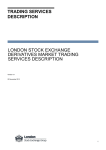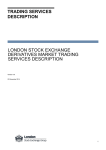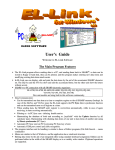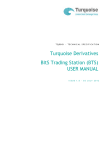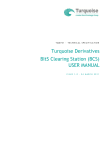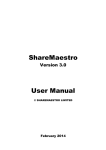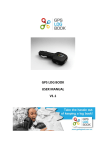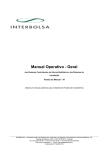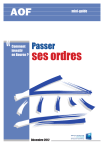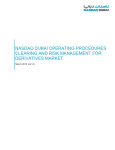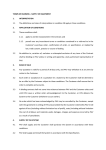Download Turquoise Derivatives - London Stock Exchange Group
Transcript
TURQUOISE DERIVATIVES TRADING SERVICE DESCRIPTION Version 2.8 1 May 2013 This service description is being distributed by Turquoise Global Holdings Limited only to, and is directed only at (a) persons who have professional experience in matters relating to investments who fall within Article 19(1) of the FSMA 2000 (Financial Promotion) Order 2005 and (b) persons to whom it may otherwise lawfully be communicated (together “relevant persons”). Any investment or investment activity to which this document relates is available only to and will be engaged in only with, relevant persons. Any person who is not a relevant person should not act or rely on this service description or any of its contents. Turquoise Global Holdings Limited is an authorised investment firm by the Financial Conduct Authority. Version 2.8 Page 1 of 28 1. About this Document ................................................................................................................................ 4 1.1. Revision History ................................................................................................................................ 4 2. About Turquoise ....................................................................................................................................... 5 2.1. Turquoise the Firm ............................................................................................................................ 5 2.2. Turquoise Services ........................................................................................................................... 5 2.3. Clearing and margining ..................................................................................................................... 5 2.4. Product Overview ............................................................................................................................. 5 2.5. Corporate Actions Treatment Rules ................................................................................................. 6 2.6. Contract Specifications ..................................................................................................................... 6 2.7. Corporate Action Identifier ................................................................................................................ 8 2.8. Strike Price Generation ..................................................................................................................... 8 2.9. Strategy instruments ......................................................................................................................... 8 2.10. Trading Functionality ........................................................................................................................ 9 2.11. Block Trades ..................................................................................................................................... 9 2.12. Trade Reporting ................................................................................................................................ 9 2.13. Bulk Quoting (product dependent) .................................................................................................. 10 2.14. Quoting Obligations for Market Makers .......................................................................................... 10 2.15. Request for Quote (RFQs).............................................................................................................. 10 2.16. On Request listing of additional standardised series ..................................................................... 10 3. Membership ............................................................................................................................................ 12 3.1. 3.2. 3.3. 3.4. 3.5. 4. Connectivity and Access ......................................................................................................................... 14 4.1. 4.2. 4.3. 4.4. 4.5. 4.6. 4.7. 4.8. 5. Transaction reporting and MIC ....................................................................................................... 17 Central Counterparty Protection ..................................................................................................... 17 Margining ........................................................................................................................................ 17 Account Structure ........................................................................................................................... 17 Market Operations and Clearing Processing Timetable ................................................................. 18 Clearing reports .............................................................................................................................. 18 Exercise and Assignment guide ..................................................................................................... 18 Risk Controls .......................................................................................................................................... 20 6.1. 6.2. 6.3. 6.4. 7. Overview ......................................................................................................................................... 14 Physical Connectivity ...................................................................................................................... 14 Vendor Access Networks (VANs) ................................................................................................... 15 Vendor Software Solutions ............................................................................................................. 15 BCS FTP Service ............................................................................................................................ 15 Trading APIs ................................................................................................................................... 16 Market Data API ............................................................................................................................. 16 Clearing API .................................................................................................................................... 16 Clearing and Market Operations ............................................................................................................. 17 5.1. 5.2. 5.3. 5.4. 5.5. 5.6. 5.7. 6. Eligibility .......................................................................................................................................... 12 Clearing Members .......................................................................................................................... 12 Trading Capacity ............................................................................................................................. 12 Market Makers ................................................................................................................................ 13 Documentation ................................................................................................................................ 13 Price Controls on Multilateral Order book Trades .......................................................................... 20 Price Controls on Block Trades ...................................................................................................... 20 Price Controls on Cleared only Trades ........................................................................................... 20 Order Quantity Controls .................................................................................................................. 20 Position Controls ..................................................................................................................................... 21 7.1. Cancellation on Disconnection ....................................................................................................... 21 Version 2.8 Page 2 of 28 7.2. 7.3. 7.4. 7.5. 7.6. 7.7. 7.8. 8. Global Cancellation of orders and bulk quotes ............................................................................... 21 Order Modification .......................................................................................................................... 21 Order Cancellation .......................................................................................................................... 21 Trade Cancellation .......................................................................................................................... 21 Drop Copy ....................................................................................................................................... 22 Bulk Quoting Protection .................................................................................................................. 22 System Protection Methodology ..................................................................................................... 22 Tariff Models ........................................................................................................................................... 24 8.1. Overview ......................................................................................................................................... 24 9. Contacts .................................................................................................................................................. 25 10. Appendix A – Order Types ..................................................................................................................... 26 10.1. Order Types for Electronic, Anonymous Orderbook Trading ......................................................... 26 10.2. Block Trades ................................................................................................................................... 27 11. Appendix B – Controls ............................................................................................................................ 28 11.1. Price and Quantity Restrictions ...................................................................................................... 28 Version 2.8 Page 3 of 28 1. About this Document The objective of this document is to provide an understanding of Turquoise‟s most relevant Technical, Operational and Business features relating to the Turquoise Derivatives market. A similar document is separately available for the Turquoise Equity market. Technical Specification documents, can be http://www.tradeturquoise.com/tq_resources.shtml found on the Turquoise website: For any feedback or queries about this document please contact [email protected] 1.1. Revision History Date Version Sections updated Notes 1 March 2011 1.0 All Published internally 1 May 2011 1.1 All Published externally 1 September 2011 1.2 3.7; 3.8; 11.2; Appendix B Additional notes on strike price generation and strategies. Definitions of Maker-Taker pricing updated. FTSE Options circuit breaker parameters added 23 September 2011 2.0 All Links added to new website documentation, information added to accommodate launch of FTSE100 Options. Section 4.7 “On request” service added. Terms and Acronyms section replaced with link to Glossary document 22 November 2011 2.1 All Terms updated to match new Rulebook, Glossary and trade cancellation procedures 5 January 2012 2.2 11 Added link to tariff schedules 21 May 2012 2.3 All Updated as result of Trade Reporting process 25 June 2012 2.4 All Updated as result of MPS Desk Closure 16 July 2012 2.5 All Updated resulted from introduction of Corporate Action policy 11 October 2012 2.6 7.5 Updated trade cancellations procedure 7 January 2013 2.7 Appendix B Update and correction of quantity / price controls 1 May 2013 2.8 9 Contact details changed Version 2.8 Page 4 of 28 2. About Turquoise 2.1. Turquoise the Firm Turquoise Global Holdings Limited (“TGHL”) is an investment firm authorised by the Financial Conduct Authority of the United Kingdom. Initially founded by a consortium of nine investment banks, TGHL is now majority owned by the London Stock Exchange Group (LSEG). In addition to LSEG, its shareholders now include twelve of the leading investment banks. 2.2. Turquoise Services TGHL operates a Multilateral Trading Facility (“Turquoise”) with two discrete trading platforms; one for cash equities and another for derivatives. Members of Turquoise can access both equity and derivatives platforms providing they have the appropriate post-trade arrangements in place. The Turquoise Equity platform offers the secondary trading of Pan-European and US equities, Exchange Traded Funds, Global Depositary Receipts, American Depositary Receipts, Exchange Traded Currency funds and Exchange Traded Commodity funds. The Turquoise Derivatives platform offers trading of single stock, index and dividend derivatives based on United Kingdom, International Order Book (IOB) and Norwegian products. The Turquoise trading platforms are hosted in the data-centres of the LSEG and have interfaces common to other markets of LSEG, ensuring that customers accessing other LSEG markets can enjoy access to Turquoise with minimal incremental cost or effort. Turquoise‟s derivatives offer Member firms new and innovative features in addition to the highly successful market models used for its existing Norwegian and IOB business developed alongside Members. 2.3. Clearing and margining Members can improve operational efficiency and net margin payments across geographies, all through one clearer - LCH.Clearnet Limited. EquityClear members can benefit (with the exception of Norwegian contracts due to interoperability arrangements) from margin offsets and cross source trade netting. 2.4. Product Overview Underlying Type Single Stock Index Norway Futures and Options on the Norwegian stocks Futures and Options on OBX Russia and IOB Futures and Options on 1 the most liquid IOB DRs Futures and Options on FTSE RIOB UK Futures and Options on FTSE100 constituents Futures and Options on FTSE 100 Dividend Market 1 Version 2.8 Futures on the most 1 liquid IOB DRs International Order Book Depository Receipts Page 5 of 28 For a current list of all products traded on Turquoise Derivatives, as well as full Contract Specifications, please refer to the Turquoise Derivatives website. 2.5. Corporate Actions Treatment Rules Where possible Turquoise harmonises the treatment of corporate actions to market standards, please refer to the Derivatives Corporate Actions Policy. For Norwegian products Turquoise follows Oslo Børs Corporate Action policy. 2.6. Contract Specifications Detailed contract specifications for each product are specified in the Turquoise Derivatives Rulebook and on the Turquoise website. A comprehensive list of product codes and underlying ISIN‟s codes can be found in the Product list on the Turquoise website. Symbology The following symbology rules apply to derivatives available for trading on Turquoise 2.6.1. Standardised Series Codes Each instrument is identified by a string of 4-9 characters (excluding Options strike) a maximum of six characters designates the Underlying instrument or Index one character designates the Expiration Year one character designates the Expiration Month (see below) (Options only) the following numeric characters designate the strike price An additional symbol may also be added to indicate that a corporate action has occurred and the readjustment rules have been applied to that series (see below). 2.6.2. Tailor-Made Series Codes Each instrument is identified by a string of 6-12 characters (excluding Options strike) Version 2.8 a maximum of six characters designates the Contract Underlying one character designates the Expiration Year two characters designate the Expiration Day one character designates the expiration month (see below) (Options only) the following numeric characters designate the strike price (Options only) an “A” or “E” designates whether the option is American or European style An additional symbol may also be added to indicate that a corporate action has occurred and the readjustment rules have been applied to that series (see below). Page 6 of 28 2.6.3. Month Code Convention Turquoise currently uses two separate month coding systems. One system is in use for IOB and Norwegian derivatives, and a separate coding system (international convention) is being used for all other products going forward. All other products Version 2.8 Norwegian and IOB Month Futures Call Options Put Options Futures Call Options Put Options January F A M A A M February G B N B B N March H C O C C O April J D P D D P May K E Q E E Q June M F R F F R July N G S G G S August Q H T H H T September U I U I I U October V J V J J V November X K W K K W December Z L X L L X Page 7 of 28 2.7. Corporate Action Identifier The presence of any of the following additional letters on the end of a series code indicates that a corporate action has occurred and the readjustment rules have been applied to that series. For example, an “R” would indicate that five corporate actions have been applied to a series during its lifetime with the readjustment rules having been applied five times. Corporate action number Identifier 1st X 2nd Y 3rd Z 4th Q 5th R 6th S 7th G 8th U 9th V 2.8. Strike Price Generation Turquoise generates new strikes on Options series according to the following: Minimum number of series in-the-money (ITM) Minimum number of series out-of-the-money (OTM) Always one series at-the-money (ATM) A pre-defined interval between each new generated series, called the “Strike Interval”. The interval between strikes can be varied on a series according to the bid price on the premium of the ATM strike. Precise details of strike price generation on a product by product basis for existing Turquoise derivatives products can be found in the “Turquoise Derivatives – Strike Price Generation document” on the website. 2.9. Strategy instruments User generated strategies On all Orderbook traded Futures and Options, Turquoise has enabled SOLA functionality that allows users to create their own 2 legged strategy instruments and list them for trading by the rest of the market. Automatically generated strategies For Orderbook traded Futures, Turquoise automatically lists “Roll” strategy instruments in addition to enabling user generated strategies. Typically, Turquoise will automatically generate a roll instrument between the expiring series and the following expiry month which are available for trading on the Orderbook. Version 2.8 Page 8 of 28 2.10. Trading Functionality Multilateral Order book Trading The Turquoise Derivatives Orderbook operates with on a Price-Visibility-Time priority basis. A summary of Orderbook types, and key information on each, is given in Appendix A. All executed trades in the Turquoise Derivatives Orderbook will contribute to price and quantity updates in the Market Data Feed (HSVF). The Risk Controls section describes controls applicable to Turquoise Derivatives. 2.11. Block Trades Turquoise Derivatives allows for the entry of bilaterally negotiated trades between counterparties (“Committed” trade) or with a single counterparty filling both sides of a trade (“Cross/ Two sided” trade). Block trades are permitted within the Bid/Ask and must conform to the specific product tick table. Please refer to the “TQD401 HSVF Market Data‟ on the Turquoise website for details. A summary of block order types, and key information on each, is given is Appendix A. Such trades are subject to different risk control parameters in addition to quantity and entry requirements. A summary of minimum block sizes on a product basis is provided in Appendix B. Block trades do contribute price and quantity updates to the Market Data Feed (HSVF). 2.12. Trade Reporting Turquoise Cleared only service offers reporting of bilaterally negotiated trades. These can be reported either in a Listed Series or Tailor-made all with the guarantee of CCP Clearing with LCH Clearnet Limited Trade Reporting provides added flexibility to tailor products to suit your needs Turquoise should be provided with details of the transaction to include: the type of and class of a Listed or Non-Standardised Contract; the term if a Tailor-made Contract the Strike Price; the style; whether it wishes to buy or to sell; the name and account(s) of the Counterparty/Counterparties In addition, Turquoise permits certain aspects of the product can be following flexible parameters Price/ Premium (configurable, product dependent) Expiration (configurable to exact day) Option exercise style (European or American style, product dependent) Tailor-made contracts are reported to Market Operations using templates provided on our website. Guidelines are also available on our website. Version 2.8 Page 9 of 28 Members are able to receive through secure FTP in Excel or CSV formats reports containing ISIN information on a Cleared only series to aid “FCA” Transaction Reporting. Please contact Market Operations for further information. 2.13. Bulk Quoting (product dependent) Members that have conformed to the Turquoise SAIL API are also able to send Bulk Quotes to the Turquoise Derivatives Orderbook. Bulk quotes may contain up to 280 separate quotes with Turquoise validating each quote within the message. Throttles apply as per rates described in the SAIL technical specification. Bulk Quoting is a more efficient way of sending quotes to the trading system as only a single message is required as opposed to multiple cancellations and resends of order messages. Bulk quotes are only valid for the current trading day. Risk/ exposure protections for Members using Bulk Quoting are described in the Risk Controls section. 2.14. Quoting Obligations for Market Makers Firms specifically assigned as Market Makers in a certain instrument class will have to meet a set of quoting obligations that are monitored in real-time by Turquoise. Market Makers should note the following: 2.15. Quotes must be sent using the Bulk Quote message in the SAIL API Quotes must meet the instrument size requirements for a minimum instrument specific percentage of the trading hours in a month Quotes must meet the instrument spread requirements for a minimum instrument specific percentage of the trading hours in a month Market Makers that do not meet their obligations over the month will not be eligible for Market Maker fees for that month and will be required to repay the difference between such fees and the non-Market Maker fees. Consistent failure to meet obligations will result in termination of “Market Maker” status and any associated agreements. Request for Quote (RFQs) Request for Quote (RFQ) allows any Member to broadcast a message to Market Makers in a particular instrument via the HSVF market data feed. Market Makers, as part of their agreement with Turquoise, have an obligation to reply by entering a quote in to the Orderbook for that specific instrument. RFQs contain: 2.16. Instrument Class Instrument ID Code On Request listing of additional standardised series Members may request by phone or electronic communication to Turquoise Market Operations for a specific Options Series to be listed on the Orderbook if it is not automatically generated in accordance with the parameters described in the relevant Contract Specifications and the Strike Price Generation document. This is known as an „On Request‟ listing. Members shall provide the following information: Version 2.8 The Underlying instrument; Page 10 of 28 Version 2.8 The Expiration Month, which should already exist on screen, (Expiration Day will always be standardised as per the relevant Contract Specification) The Strike Price (should be within the same strike price interval that already exists). Page 11 of 28 3. Membership 3.1. Eligibility Members and prospective members are required to satisfy the Membership criteria applied by Turquoise appropriate to the capacity in which they intend to act. Must be an EEA regulated investment firm or credit institution (as defined under MiFID); or The applicant must show that it is fit and proper; and Turquoise Management must be satisfied that the Applicant has or will have sufficiently completed conformance testing prior to conducting business on Turquoise. This also applies to mandatory system upgrades; and Turquoise Management must also be satisfied that the Applicant has adequate organisational arrangements and a sufficient level of trading ability and competence and other relevant systems and controls; and The Applicant must be a clearing member of a central counterparty approved by Turquoise Management for derivatives trading or have made satisfactory arrangements with an entity in order to guarantee the clearing of any transactions executed on Turquoise. 3.2. Clearing Members Firms may take membership of Turquoise Derivatives in one of three clearing capacities: General Clearing Member (GCM) – is a member of Turquoise and has a direct membership of the Designated Clearing House with respect to Turquoise Derivatives and is also approved to act in a clearing capacity on behalf of Non-Clearing Members (NCMs) Individual Clearing Member (ICM) – is a member of Turquoise and has a direct membership of the Designated Clearing House with respect to Turquoise Derivatives. Unlike a GCM, an ICM may only clear its own business. ICMs wishing to become GCMs should contact LCH and Turquoise Market Operations stating their intention. Non-Clearing Member (NCM) – is a member of Turquoise but has no direct membership of the Designated Clearing House with respect to Turquoise Derivatives. NCMs must use a GCM to clear their business. The GCM will set up a tri-party “LCH-NCM-GCM Agreement” between themselves, the NCM and LCH.Clearnet (the Designated Clearing House). Only once Turquoise Market Operations has received confirmation from LCH.Clearnet that this agreement is in place, will an NCM be able to begin trading. The Turquoise Rulebook (available on the Turquoise website) contains further details on requirements and eligibility for each of the above. 3.3. Trading Capacity Firms may effect transactions on Turquoise in one of three capacities: 1. Broker (acting on behalf of clients) 2. Proprietary trader (house business); or 3. Market Maker It is the responsibility of each member to ensure that transactions entered into on Turquoise are allocated to the correct Account. Version 2.8 Page 12 of 28 3.4. Market Makers Firms wishing to act as Market Makers on Turquoise‟s markets and therefore benefit from pricing incentives and revenue sharing schemes in certain products will need to sign a supplementary agreement. This is done after consultation with Turquoise Business Development as well as having satisfied Turquoise that it has the necessary regulatory authorisation and technical capability. 3.5. Documentation Turquoise membership documentation (covering both cash and derivatives membership) can be requested by contacting Turquoise Business Development Team or by downloading from the Turquoise website: http://www.tradeturquoise.com/tq_joining.shtml Version 2.8 Page 13 of 28 4. Connectivity and Access 4.1. Overview Trading Clearing Market Data SAIL API FIX 4.2 API BCS API HSVF API Application API and Connectivity Extranex Hosting VPN NSP Vendor Access Network (VAN) VAN* provided network and applications Turquoise solution External solution BTS Member In-House GUI ISV provided GUI* BCS CC&G FTP site ISV GUI* BTS Market Data Vendor* *See Turquoise website for a full list: http://www.tradeturquoise.com/tq_vendors.shtml Please refer to the “TQD102 Connectivity Guide” on the Turquoise website for further details on the connectivity options listed below. 4.2. Physical Connectivity Extranex Extranex provides customers of the London Stock Exchange Group, including Turquoise MTF (Derivatives and Equity) Members with a dedicated, resilient and secure point to point connection allowing transmission of data traffic to and from the Group‟s Trading, Clearing and Information Systems. A range of service options are available to suit varying customer requirements. See the London Stock Exchange website or contact Turquoise‟s technical team for more details: http://www.londonstockexchange.com/products-and-services/connectivity/extranex/extranex.htm Hosting Members may choose to house their servers in LSEG‟s data centre in close proximity to the Turquoise Derivatives servers. Virtual Private Network (VPN) For Members seeking a low cost solution and who are less sensitive to latency, Turquoise will configure and deliver a router to allow trading and clearing access over a standard internet connection. Version 2.8 Page 14 of 28 Network Service Providers (NSP) As an alternative to using the Extranex network, the Group‟s services, including Turquoise Derivatives, can also be accessed through accredited NSPs. Members contract with the NSP for provision of network connectivity but sign agreements directly with Turquoise for access to our trading and information services. Clients using an NSP connection will have individual service enablement‟s set up on our trading, clearing and information systems. The data and trading feeds (APIs) are in exactly the same format as those received by a direct customer and are subject to the same testing requirements. A list of all current NSPs for Turquoise Derivatives can be found on the Turquoise website. 4.3. Vendor Access Networks (VANs) VANs provide a full end to end solution comprising network connectivity and pre-conformed software applications through which their clients can interface with Turquoise Derivatives. 4.4. Vendor Software Solutions MDVs, ISVs and VANs A full list of Turquoise Derivatives conformed Front, Middle and Back Office Independent Software Vendors (ISVs), Market Data Vendors (MDVs) and VAN providers can be found on the Turquoise website: http://www.tradeturquoise.com/tq_vendors.shtml BTS Trading Application The Borsa Italiana Systems (BItS) Trading Station (BTS) Service allows access to Turquoise Derivatives trading services. In addition, it is also used to access all other London Stock Exchange Group Equity, Fixed Income and Derivatives markets. Turquoise can supply BTS to members as an off-the-shelf ready-made trading application. Using BTS, members can access functionality including order entry, deletion, viewing of the Orderbook to five levels of depth, creation of strategy instruments and the reporting of Cross and Committed block trades. BTS cannot be used for market making activity such as bulk quoting and market maker protection. The following BTS documents are available from the Turquoise website: TQD801 BItS Trading Station (BTS) User Manual BCS Clearing Application Members can develop directly Turquoise Derivatives clearing API, however most clearing members will take the Turquoise supplied BCS application to enable them to view reports, perform give ups/ take ups, move trades between accounts and perform other post trade administration. The following BCS documents are available from the Turquoise website: TQD701 BItS Clearing Station (BCS) User Manual TQD702 BItS Clearing Station (BCS) Application Data Layouts TQD703 BItS Clearing Station (BCS) Technical Notes 4.5. BCS FTP Service Turquoise clearing reports are available via an FTP site accessible with a user name and password Contact Technical Account Management for FTP Service documentation Version 2.8 Page 15 of 28 4.6. Trading APIs Turquoise provides two derivatives trading APIs that applications can be developed to. These are: FIX 4.2 SOLA Access Information Language (SAIL) – the SOLA native API The native SAIL API provides a slight latency advantage over the FIX API along with additional functionality for bulk quoting. The following FIX and SAIL documentation is available from the Turquoise website including the SOLA 5 Release documentation TQD200 - FIX 4.2 Business Design Guide TQD201 - FIX 4.2 Specification TQD300 - SAIL Business Design Guide TQD301 - SAIL Specification 4.7. Market Data API Turquoise provides a single market data API that applications can be developed to. This is: High Speed Vendor Feed (HSVF) HSVF disseminates trades, quotes, request for quotes, market depth, trade cancellation, strategies, bulletins, instrument keys, instrument summaries and administrative messages for all order-book traded derivatives on Turquoise. HSVF uses a TCP/IP broadcast interface. Users may subscribe to: Level 1 data – best bid and ask price and aggregate size, last trade price and size and other market data as detailed in the documents listed below. Level 2 data – level one data augmented with a further four levels of price depth and size The following HSVF documentation is available from the Turquoise website including the SOLA 5 Release documentation: TQD401 - HSVF Market Data Members wishing to redistribute market data must do so under the terms of the ILA and should refer to our Tariff Schedule, or contact the Turquoise Business Development team for more information. 4.8. Clearing API Turquoise provides a clearing API that applications can be developed to for the purpose of allowing clearing processing and trade administration. The documentation is available on request from Technical Account Management. Version 2.8 Page 16 of 28 5. Clearing and Market Operations 5.1. Transaction reporting and MIC Every series on Turquoise has an associated ISIN code. This ISIN is a unique identifier that can be used for transaction reporting purposes. Each series can also be identified by its unique series level code, described in the symbology section. The Market Identifier Code (MIC) for Turquoise derivatives is TRQD. 5.2. Central Counterparty Protection All Future and Option Contracts traded/reported on Turquoise will have LCH.Clearnet Limited acting as Central Counterparty. At the point of trade registration, trades are novated to LCH.Clearnet Limited whereby the trade by assuming a long position against the short counterparty to the trade, and a short position against the long counterparty. 5.3. Margining Initial margin is calculated and collected by LCH.Clearnet Limited using London SPAN V 4.0 which is a portfolio based margining system. There are three major inputs to the London SPAN margin calculation, Positions, Prices and Parameters (determined by LCH.Clearnet and reviewed on a continual basis). Any change to any one of these parameters will result in a change to the margin requirement. Turquoise calculate daily variation margin of a members‟ profits or losses using the Daily Settlement Price to mark-to-market open positions. The collection/return of variation margin is administered by LCH.Clearnet Limited. Derivative outurns with the exception of Turquoise Derivatives Norwegian contracts benefit from margin offsets and optional cross trade source netting through LCH Clearnet EquityClear Service. Buyer elections on all physical delivered contracts, excluding the Turquoise Derivatives Norwegian contracts, will be allowed under the Equityclear Service. Members will have the ability to choose an option or combination of options, in a participating Corporate Action giving more control over their investments, as opposed to the current default option process. 5.4. Account Structure Members can request the following types of account from Turquoise Derivatives Market Operations. Client account House account Market Maker account (for members under provision obligations and able to use bulk quote protection) Market Operations will supply the member with a “Static Data Form” upon request, on which account set up requirements can be specified. The member can then segregate business as required. Version 2.8 Page 17 of 28 5.5. Market Operations and Clearing Processing Timetable Times may vary depending on market conditions Market Operations opens 07:30 Clearing closes (read-only access available in BCS) Clearing batches begin 18:00 18:45 (BCS inaccessible) Clearing reports available 19:00 Market Operations closes 19:00 Official closing prices disseminated (can be amended over-night) 21:00 All times are London times Until clearing closes at 18:00 daily, members are able to perform trade administration such as give ups/ takes ups, position transfers and close outs in the clearing system. 5.6. Clearing reports Members can extract reports summarising their activity on Turquoise Derivatives from the clearing API and clearing applications (including the CC&G FTP Server). For more detail on these reports and how to access them, please refer to the Connectivity and Access section, 5.7. Exercise and Assignment guide Currently, Turquoise offers two Options styles on its derivatives markets with the following exercise windows: Exercise window Option style Exercise Open Close American style Any business day from trade date until day before expiry 07:30 18:00 European style and American style Expiry day only 18:10 18:40 All times are London times Version 2.8 Page 18 of 28 Turquoise applies the following automatic exercise rules on expiration: Market Index Options Stock/ DR Options Norway All series that are in-the-money by more than the exercise fee payable All series that are 1% or more in-themoney IOB All series that are in-the-money by more than the exercise fee payable All in-the-money series UK All in-the-money series All in-the-money series Manual exercise can be performed through the member‟s clearing application (for example on a Norwegian series that is less than 1% in-the-money). Version 2.8 Page 19 of 28 6. Risk Controls 6.1. Price Controls on Multilateral Order book Trades Circuit breakers will activate and trigger a 60 second suspension of trading when a trade occurs at a price level deemed to be an unacceptably large percentage margin away from static or dynamic control prices defined by Turquoise. Turquoise can set separate circuit breakers against the static control price with respect to both orders and trades. The acceptable margin can be configured both above and below the control price separately if required however Turquoise has chosen to use the same figure above and below for all products to date. Definitions of control prices are as follows: Static control price – the previous day closing price as determined by Turquoise and CC&G OR a manually inputted price; Dynamic control price – the last traded price in the current session Levels set by Turquoise are detailed in Appendix B. For Stop Loss and If Touched orders, the incoming order price cannot be outside the price control thresholds detailed in Appendix B. Additionally if, when triggered, the price on such an order violates on of the control parameters, the incoming order is deleted and the circuit breaker suspension is triggered. 6.2. Price Controls on Block Trades Block trades electronically submitted to Turquoise will be subject to the following controls: Where the price of the block falls outside the real-time bid/ ask spread, Turquoise defines a minimum acceptable quantity for the trade which is product specific. Turquoise sets a maximum permitted percentage deviation from the real-time bid/ ask spread for such block trades. Any block trade at a price more than this percentage below the bid/ above the ask, will not be processed. Where the price of the block falls inside the real-time bid/ ask spread, the trade is subject to normal order quantity controls as detailed in 6.4. Product specific settings are in detailed in Appendix B. 6.3. Price Controls on Cleared only Trades All Cleared only trades are processed by Turquoise Market Operations with open interest kept separately from the Listed Series open interest. All Cleared only trades are subject to fair value price control by Turquoise surveillance. 6.4. Order Quantity Controls Single orders or combination orders are reviewed by Turquoise surveillance for purposes of market quality. Product specific settings are in detailed in Appendix B. Version 2.8 Page 20 of 28 7. Position Controls Turquoise monitors positions and may place limits on their size. LCH Clearnet Limited will request margin on all positions and it is each member‟s responsibility to meet their margin requirements 7.1. Cancellation on Disconnection Members should be aware of the following; When conducting the login procedure, SOLA allows for the member to specify an “inactivity interval” which indicates the number of system “heartbeats” that must be missed before the Member is considered disconnected. This only applies to “While Connected” orders and not to GTD or GTC orders. If the inactivity interval is set to “0” then the user is never considered to be disconnected “Good Till Day” and “Good Till Cancelled” orders will not automatically cancel on disconnection Turquoise therefore strongly recommends the use of “While Connected” orders for Members that are concerned about cancellation on disconnect. 7.2. Global Cancellation of orders and bulk quotes Members wishing to remove all their orders from the Orderbook in one go should contact Turquoise Market operations who can perform this action. A specific Global Cancellation message, applying only to quotes placed using the Bulk Quote message, can be sent by Bulk Quote users and will pull all quotes related to a specific trader on all instruments in the same class. The Trader ID and instrument Group ID are used to specify which quotes to cancel. Separate orders will not be cancelled. 7.3. Order Modification A member may modify any order still on the Orderbook. The following modifications will affect price and time priority: Modification Price priority Time priority Quantity decrease Maintained Maintained Quantity increase* Maintained Lost Price change* Lost Lost *results in deletion of original order and entry of a new order with new price time priority and associated order number 7.4. Order Cancellation A Member may cancel any order still on the Orderbook by sending a cancellation message to the trading system or by contacting the Market Operations. 7.5. Trade Cancellation Requests for cancellations of bilaterally negotiated trades should be made to Market Operations. Version 2.8 Page 21 of 28 Requests for cancellation of trades done via the Orderbook should be made to Market Surveillance. All requests for cancellations must follow the rules set out in the Rulebook. 7.6. Drop Copy The drop copy feature allows drop copy participants to receive a copy of all order acknowledgements and trade notifications that belong to a specific Member. Drop copy messages are all sent using the SOLA Access Interface Language (SAIL), even where the Member‟s original order protocol was FIX. SAIL messages included in the drop copy are: Message Order Acknowledgement Order Modification Acknowledgement Order Cancellation Acknowledgement Order Cancellation Notice Execution Notice* Leg Execution Notice* Execution Cancellation notice* Leg Execution Cancellation Notice* * contains “Maker-Taker” flag For more information on drop copy functionality please refer to the following document on the Turquoise website TQD302 SAIL Drop Copy 7.7. Bulk Quoting Protection Bulk quoting protection is a Turquoise Derivatives provided function that will result in an automatic cancellation of all quotes in a particular instrument class. The feature protects only assigned Market Makers against any “excessive” trades due to the following: Technical problems at participant‟s end preventing normal market updates Quoting errors at participant‟s end due to erroneous underlying price information Unintentionally being “swept” by another Market Maker 7.8. System Protection Methodology Version 2.8 Users may opt for one of two types of bulk quoting protection: Page 22 of 28 o Standard protection: If protection is triggered on an instrument class, quoting will be restarted and counters (detailed below) reset the next time the Market Maker sends a bulk quote message to any instrument in the class. o Advanced protection: If protection is triggered on an instrument class, any subsequent quote update is rejected and quoting can only be resumed after the Market Maker has sent a new “Market Maker protection subscription” (RP) message Once protection is triggered, Turquoise will automatically cancel all quotes posted by the trader on all instruments in the class and send a “Notice of cancellation of all quotes” (NP) message. Bulk quoting protection is active on all quotes sent using the Bulk Quote message functionality Turquoise provides five protection counters which can be set by firms specifically assigned as Market Makers in a specific instrument class Any number of counters can be activated simultaneously Traders must define a “Time Interval” The protection counters are reset in the event that the time elapsed between any two trades is longer than the user defined “Time Interval”. Protection counters are listed and described in the table below: Counter type Counter change condition (applies to all trades in any instrument of the class) Trigger for bulk quoting protection Trade counter Increases by 1 with each execution of a trade of at least N lots (where N is a user defined number) User defined number of trades of at least N lots in size Volume counter Value counter Increases by the trade volume of every execution Increases by the trade value of every execution User defined volume User defined value Increases by trade volume of every bought call option, Delta volume counter sold put option and bought future; and Decreases by trade volume of every sold call option, User defined net volume bought put option and sold future Increases by trade value of every bought call option, Delta value counter sold put option and bought future; and Decreases by trade volume of every sold call option, User defined net value bought put option and sold future Version 2.8 Page 23 of 28 8. Tariff Models 8.1. Overview Turquoise operates several products with its specific pricing models. Tariff schedules are available on the Turquoise website: The different tariff models currently in use on Turquoise Derivatives are detailed below. Per-Contract Maker-Taker For every trade that happens on the Turquoise SOLA Orderbook, one counterparty to the trade is designated the “Passive/ Maker” side and the other is designated the “Aggressive/ Taker” side. Passive/ Maker side: Relates to an order that is resting on the Orderbook awaiting the entry of an opposite order against which it will be able to execute. Aggressive/ Taker side: Relates to an incoming order that instantaneously executes against an opposite order already resting on the Orderbook. The maker-taker system differentiates charging based upon the above distinction. So: The maker in each trade pays a fee to Turquoise equal to the passive fee multiplied by the number of contracts in the trade The taker in each trade pays a fee to Turquoise equal to the aggressive fee multiplied by the number of contracts in the trade Fees on either side may be positive or negative, a positive fee equates to a payment from the member to Turquoise, a negative fee equates to a rebate payable by Turquoise to the trading member. NB: Maker-taker pricing does not apply to block trades or Trade Reported/Tailor-made trades Fee per lot Products using this system simply apply one universal fee to each side of the trade based on the number of contracts traded., Per-Trade Charging Percentage of Futures value Some products are charged based on a “percentage of future value” system, for example IOB dividend Futures. Future Value = (future price traded) x (number of contracts) x (multiplier) Percentage of premium value Some products are charged based on a “percentage of premium value” system, for example IOB DR Options Version 2.8 Premium Value = (premium) x (number of contracts) x (multiplier) Page 24 of 28 9. Contacts For more information on Turquoise Derivatives, or any services offered by Turquoise, please contact a member of our team. Department Business Development and Membership Enquiries Derivatives Market Operations Equities Market Operations Telephone Email +44 (0) 20 7382 7650 [email protected] +44 (0) 20 7797 3617 [email protected] + 44 (0) 20 7382 7676 [email protected] Market Surveillance +44 (0) 20 7797 1578 [email protected] Corporate Actions team +44 (0) 20 7797 3660 [email protected] +44 (0) 20 7797 3939 [email protected] +44 (0) 20 7797 1500 [email protected] Technical Account Management Functional Queries, Client On-Boarding, Technical Advice Client Support Team Incident Management (Live Service and CDS) Market Access User Setups, Certification Testing, Connectivity Testing [email protected] Office Address 10 Paternoster Square London EC4M 7LS T: +44 (0) 20 7382 7600 F: +44 (0) 20 7382 7690 W: www.tradeturquoise.com Version 2.8 Page 25 of 28 10. Appendix A – Order Types Order Types for Electronic, Anonymous Orderbook Trading Duration type Quantity type Price type 10.1. Order type Description Limit order Enters Orderbook at specified price and will execute at that level or better. Residual is retained on order-book (unless designated as an immediate order) until withdrawn or traded. Market order Executes at best available price until all volume on opposite side has been traded. Residual is converted to a limit order at last price that original order was executed. Top order Executes at best available price against any single contra order. Residual is converted to a limit order at price just traded. Stop (loss) order Order enters book to prevent further loss once either the Last price or Bid or Ask (as selected) reaches a stated trigger price. Entering order can be set as limit order by entering a specific order price. Alternatively, it can be set as a market order by leaving the order price field blank. Residual is retained on order-book. If-Touched order Order enters book seeking to capitalise once either the Last price or Bid or Ask (as selected) reaches a stated trigger price. Entering order can be set as limit order by entering a specific order price. Alternatively, it can be set as a market order by leaving the order price field blank. Residual is retained on order-book. Minimum quantity order Tries to execute at the specified price for at least the stated „Additional Quantity‟ (AQ). If the AQ cannot be immediately filled, the order is rejected. If the AQ is filled, the residual is retained on the Orderbook and can trade without further quantity constraints. Iceberg/ disclosed quantity order Enters book as Limit order for only the „Additional Quantity‟ (AQ) visible, and any balance is held “in reserve”. The visible quantity is assigned time-priority at the point of insertion in relation to other displayed orders, whilst the reserve quantity is assigned time priority in respect of other non-displayed orders. When this disclosed/ AQ amount has been traded, the system refreshes the visible quantity from the reserve quantity. Day order Remains on the book and cancelled at end of the day unless traded or deleted. Good Till Day (GTD) Version 2.8 Good Till Cancelled (GTC) Remains on the book and cancelled at the end of the day specified in the GTD field unless traded or deleted. Remains on the book until expiration unless traded or deleted. Immediate order (FAK/ IOC) Immediately executed against any existing orders at the specified price of better, up to the stated volume. Residual volume is deleted. While connected order Remains on the book until participant disconnection or front end failure unless traded or deleted. Page 26 of 28 10.2. Block Trades Price type Order type Committed (interbank) Cross (intrabank) Version 2.8 Description Matching facility to support reporting of executions negotiated between different members for the purpose of trade publication and clearing. Trades must specify the intended counterparty and do not interact with the anonymous multilateral orderbook. Trades stay in the committed book until the end of the day unless matched or deleted. Effect market data Trades must meet certain quantity and price threshold determined by Turquoise on a product specific basis, Trades contribute to the Market Data Feed with quantity and price updates Trade is pre-arranged by one member acting on behalf of each side and reported to Turquoise. Trades do not interact with the anonymous multilateral orderbook. Matching requirements Both sides must enter a committed trade with opposing buy and sell sides, same price, same quantity and the correct counterparty or the trades will not match. Committed trades not matched by the end of the trading session are automatically deleted. Matching not required as trade details are entered by one participant only. Page 27 of 28 11. Appendix B – Controls 11.1. Price and Quantity Restrictions Orderbook price control Minimum quantity for outside spread Allowable % from bid/ask +/- 1.5% 250 lots +/- 7.5% - - 1 lot OBX - - Norwegian stock - IOB DRs Trade reporting price control Block trade quantity control Combo order maximum Single and combo order minimums Single and combo order maximums 1 lot Within bid/ask spread 500 lots 2500 lots 250 lots 5,000 lots Within bid/ask spread 1 lot Within bid/ask spread 500 lots 2,500 lots 1 lot 5,000 lots 1 lot Within bid/ask spread 1 lot Within bid/ask spread 50,000 lots 50,000 lots 1 lot 50,000 lots - 1 lot Within bid/ask spread 1 lot Within bid/ask spread 50,000 lots 50,000 lots 1 lot 50,000 lots - - 1 lot Within bid/ask spread 1 lot Within bid/ask spread 10,000 lots 10,000 lots 1 lot 60,000 lots IOB DR dividends - - 1 lot Within bid/ask spread 1 lot Within bid/ask spread 10,000 lots 10,000 lots 1 lot 100,000 lots FTSE 100 - - 250 lots +/- 7.5% Not allowed 500 lots 2500 lots 250 lot 5,000 lots 1 lot Within bid/ask spread 5,000 lots 10,000 lots 1 lot 10,000 lots % from dynamic control +/- 7.5% for orders +/- 3.5% for trades FTSE RIOB FTSE 100 Futures Orderbook quantity control Single order maximum % from static control Product Options Block Trade price control FTSE RIOB - - 1 lot Within bid/ask spread OBX - - 1 lot Within bid/ask spread 1 lot Within bid/ask spread 50,000 lots 50,000 lots 1 lot 50,000 lots IOB DRs - - 1 lot Within bid/ask spread 1 lot Within bid/ask spread 10,000 lots 10,000 lots 1 lot 30,000 lots Norwegian stock - - 1 lot Within bid/ask spread 1 lot Within bid/ask spread 50,000 lots 50,000 lots 1 lot 50,000 lots Version 2.8 Page 28 of 28





























